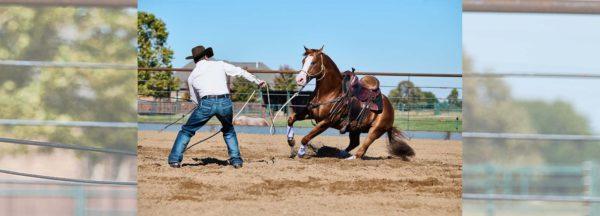Training Tip: A Good Foundation is Everything

You often don’t appreciate a good foundation until you don’t have it. Think about it. If you’ve got a well-built house, you don’t give its foundation a second thought. But if you’re living in a house with a faulty foundation, you’re forced to think about it every day. Why are the floors uneven? Why are there cracks in the walls? Why is the roof leaking? It all goes back to the foundation.
The same is true of horses. If you have a horse that was started correctly and has a great foundation of respect in place, you find it easy to get along with him. Nothing you do is ever a big concern. The few times that he does react or hesitate, you’re able to get him on the right track with little problems thanks to his foundation. On the other hand, if you’re working with a horse that has no foundation in place, it’s evident every day that you are around him. Any time you try to correct a bad behavior, 10 more show up.
The Method is all about giving horses a solid foundation from which to excel in any given discipline. It doesn’t matter what a horse does for a living— reining, dressage, cow horse, jumping, trail riding—no matter what he does, he needs to be safe, willing, respectful and easy to control. All of the exercises in the Method, starting with Fundamentals groundwork and progressing through Advanced riding, are designed to do just that.
If you’ve been following the Method for any length of time, you’ve no doubt heard me repeatedly talk about the issue of how important a foundation is and why teaching your horse the Fundamentals exercises takes care of 95 percent of all horse problems. This knowledge may even be so ingrained with how you interact with horses that it’s become second nature—you don’t have to stop to think about it.
When I was doing a lot of expos, after teaching a demonstration, I’d go back to my booth to visit with horsemen and answer their training questions. Many of the attendees were relatively new horsemen and I’d get a lot of questions about how to fix behavioral problems. I’d go into a big, long answer about how you need to earn your horse’s respect, but people hate that answer. When I tell them that they need to teach their horse the Fundamentals groundwork exercises, they think
I’m just trying to sell them something. They want me to say something like, twist his ear, slap his hindquarters and he’ll be fixed. It’s not necessarily that they’re not really wanting to have a true partnership with their horse, they’re just too inexperienced to know that horsemanship doesn’t work that way.
I suppose it’s like if you’re an IT tech working on a computer issue, no one has to remind you to doublecheck that the piece of equipment is plugged in before you start troubleshooting it. It’s one of the first things you automatically check, and in fact, to you, it’d be a joke if you didn’t check that. But if you’ve never worked with a computer before and aren’t familiar with it, you might not check if it’s plugged in or not. And no one could blame you—you’re not familiar with it!
That’s why it’s important that my clinicians and ambassadors are reaching new horse owners. They have the ability to interact with individuals one-on-one and ensure that they get the knowledge they need to stay safe, get results and have fun with their horses.
Have a horsemanship question or looking for more training tips? Check out the No Worries Club.
